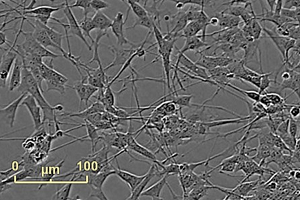Cell line profile SH-SY5Y
(ECACC catalogue no. 94030304)
Cell line history
SH-SY5Y cells were derived through three successive sub-clones of the parental SK-N-SH cell line1; originally isolated from a metastatic bone tumour biopsy from a 4 year old female child suffering from neuroblastoma, a rare nerve cell cancer2. Subsequent genetic profiling (short tandem repeat (STR) analysis) has confirmed that SK-N-SH and SH-SY5Y are from the same donor despite their different phenotypes.

Neurite expression in ECACC SH-SY5Y cells induced by 7 days exposure to 10um all-trans retinoic acid (ATRA) in Neurobasal Medium+B27 supplement Neurites are seen as thin, long cytoplasmic projections.
Key characteristics
Chemicals such as retinoic acid can induce differentiation in SH-SY5Y cells. Under these conditions the cells express cell neurites and adopt a neuron-like phenotype3 4. Both undifferentiated and differentiated SH-SY5Y have been reported to express dopaminergic neuronal markers and muscarinic and nicotinic adrenergic receptors. Differentiated SH-SY5Y may be driven towards an adrenergic phenotype
Applications
Mechanistic laboratory based models of human neuronal systems are useful in neurobiology, not only into research into the understanding of brain function and development but also in the fields of neurological disease, neuro-toxicology, disorders such as depression and degenerative diseases such as Parkinson’s and Alzheimer’s5 6 7. Primary human cell culture models are limited as differentiated neurons can longer be proliferated in culture and present associated ethical constraints. Standardised stocks of SH-SY5Y cells have the advantage of the proliferative potential of an immortal cancer cell line combined with ability to be differentiated into neuron-like cells that can then be used in functional assays.
Culture tips
There is anecdotal and experimental evidence that through continuous subculture (or passaging) SH-SY5Y cells start to lose their neuronal characteristics and the potential to generate neurites. The consensus is that cells should be maintained below passage (P) 20. It is therefore important that you should manage your stocks of the cell line appropriately. Typically ECACC SH-SY5Y cells are supplied at around P12. We advise that you subculture the cells at a ratio of 1:10 or higher, seeding at a maximum of 1x104 cells/cm2 and that you prepare your own cryopreserved working stocks of the cells within two passages of receipt (i.e. around 30 vials at P14). Using this strategy, splitting at a split ratio of 1:10, each individual vial of your working stock would be capable of being expanded 106 (up to 1 million times) before the arbitrary P20 limit. Seeding at higher split ratios (up to 1:100) and lower seeding densities (as low as 1,000 cells/cm2) can further maximise the use of your cells.
Propagation of SH-SY5Y cells should be carried out using conventional cell culture techniques in Ham's F12/EMEM (EBSS) + 2mM Glutamine + 1% Non-Essential Amino Acids (NEAA) + 15% Foetal Bovine Serum (FBS). Neuronal differentiation, however, should be performed using a chemical agent such as retinoic acid in an appropriate basal medium (such as Neurobasal Medium +B27 Supplement). After several days’ exposure, typical neurite extension can be seen.
|
Related cell line |
|---|
|
SK-N-SH (ECACC catalogue no. 86012802) |
Key references
-
Biedler, J. L., Helson, L. & Spengler, B. A. Morphology and Growth, Tumorigenicity, and Cytogenetics of Human Neuroblastoma Cells in Continuous Culture. Cancer Res. 33, 2643–2652 (1973).
-
Biedler, J. L., Roffler-Tarlov, S., Schachner, M. & Freedman, L. S. Multiple Neurotransmitter Synthesis by Human Neuroblastoma Cell Lines and Clones. Cancer Res. 38, 3751–3757 (1978).
-
Kovalevich, J. & Langford, D. Considerations for the use of SH-SY5Y neuroblastoma cells in neurobiology. Methods Mol. Biol. Clifton NJ 1078, 9–21 (2013).
-
Agholme, L., Lindström, T., Kågedal, K., Marcusson, J. & Hallbeck, M. An in vitro model for neuroscience: differentiation of SH-SY5Y cells into cells with morphological and biochemical characteristics of mature neurons. J. Alzheimers Dis. JAD 20, 1069–1082 (2010).
-
Jämsä, A., Hasslund, K., Cowburn, R. F., Bäckström, A. & Vasänge, M. The retinoic acid and brain-derived neurotrophic factor differentiated SH-SY5Y cell line as a model for Alzheimer’s disease-like tau phosphorylation. Biochem. Biophys. Res. Commun. 319, 993–1000 (2004).
-
Cheung, Y.-T. et al. Effects of all-trans-retinoic acid on human SH-SY5Y neuroblastoma as in vitro model in neurotoxicity research. NeuroToxicology 30, 127–135 (2009).
-
Koriyama, Y., Furukawa, A., Muramatsu, M., Takino, J. & Takeuchi, M. Glyceraldehyde caused Alzheimer’s disease-like alterations in diagnostic marker levels in SH-SY5Y human neuroblastoma cells. Sci. Rep. 5, 13313 (2015).
